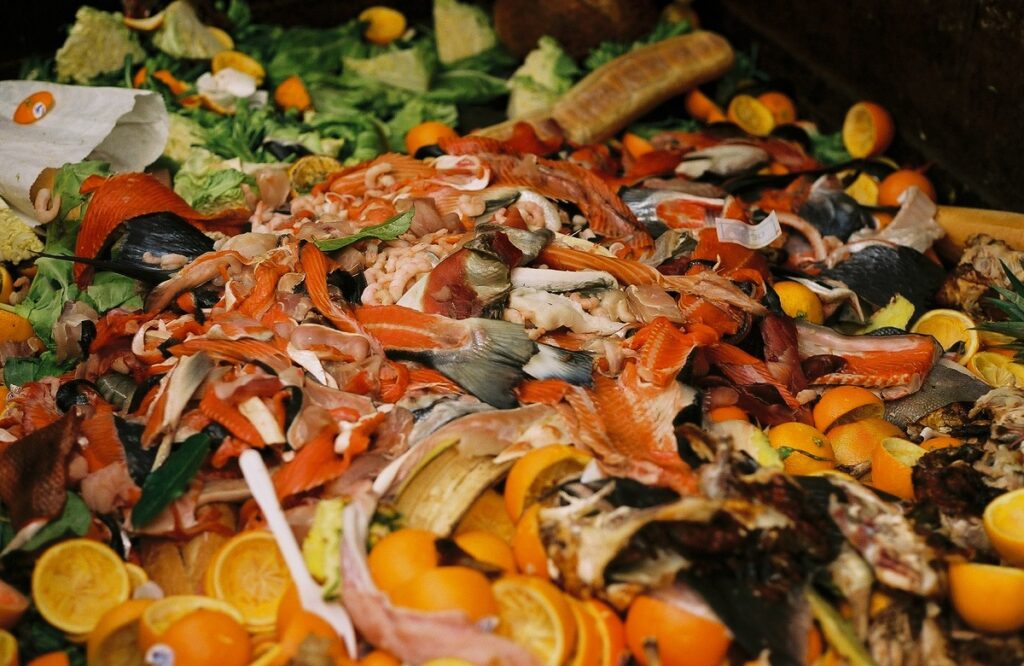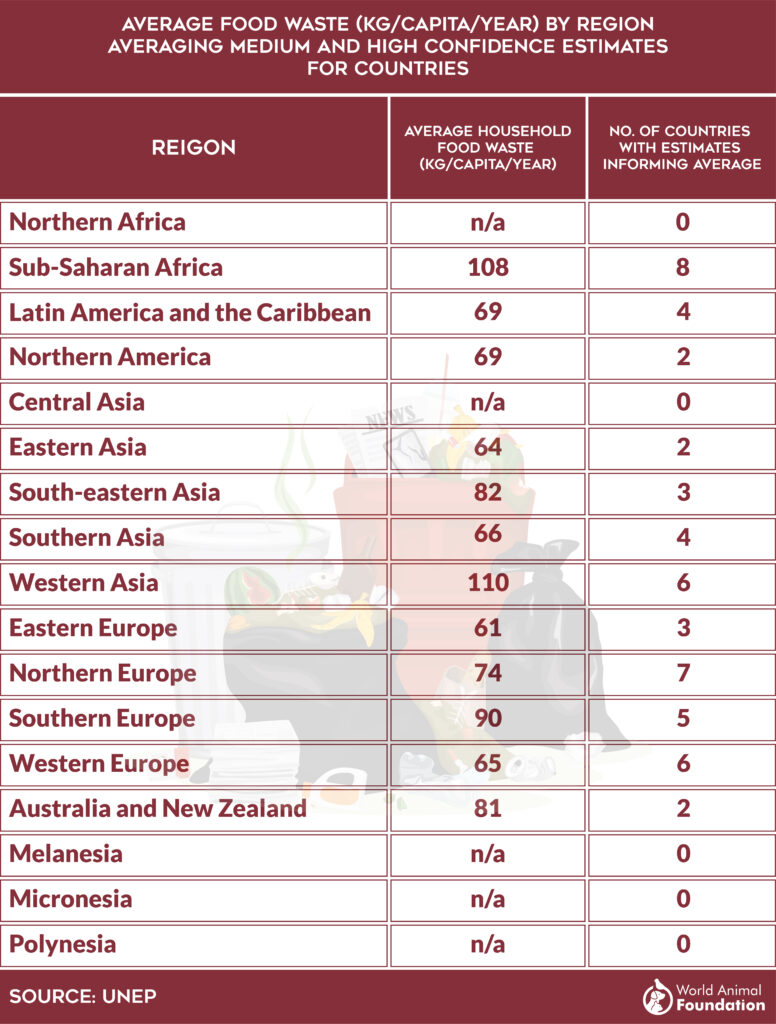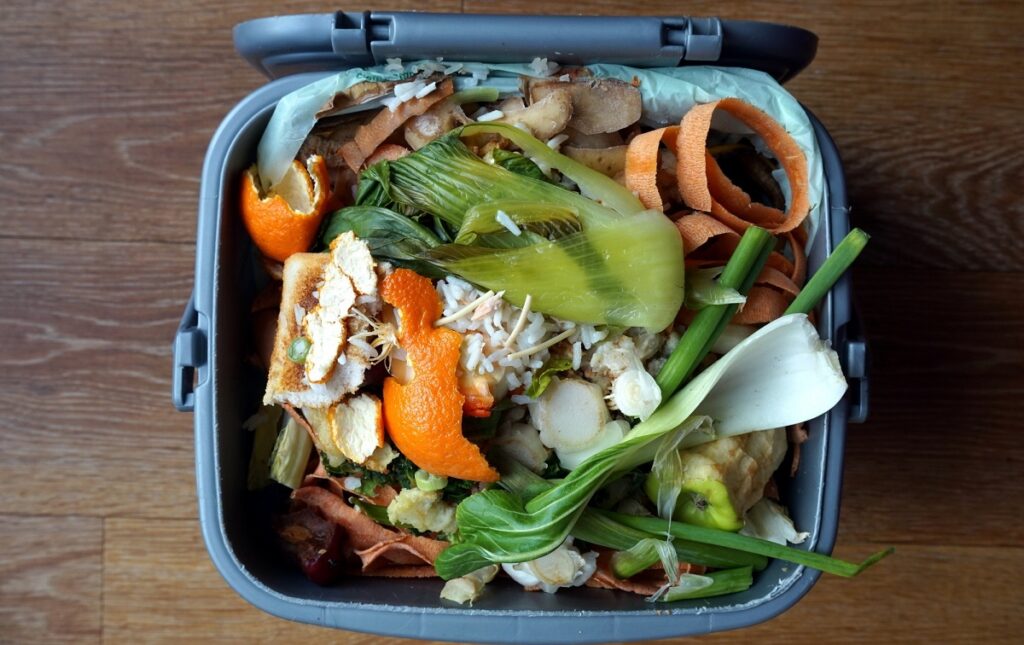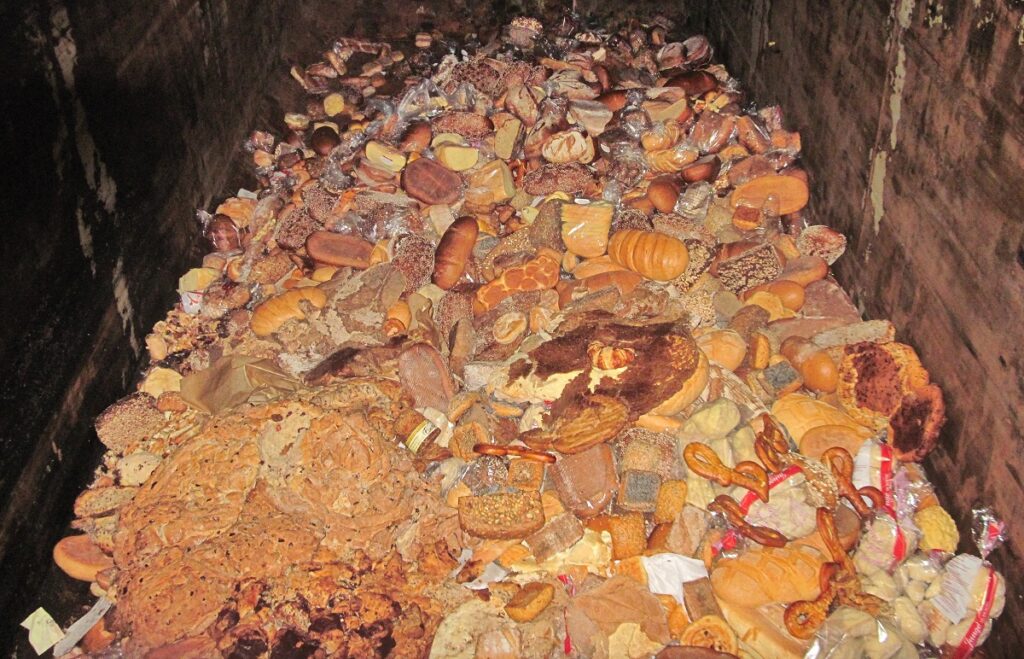In the United States alone, practically 40% of the entire food supply is wasted — 325 pounds by each person is thrown out. Landfills are full of perfectly good food that hungry people need, and resources are wasted to produce food that no one will eat.
Food rescue is donating leftover food from events and restaurants and selling/donating perfectly edible misshapen produce. Fresh foods’ appearance shouldn’t be factored into quality standards because 60 million tons of many fruits and veggies are tossed out.
Some organizations are sending food that would otherwise be thrown out to those who need to eat. We must continue to perfect the methods to send hungry people the food that others don’t eat and throw out.
Read on for interesting food waste facts.
Top 10 Astonishing Food Waste Facts
- Approximately 1.3 billion tons of food is wasted globally
- The carbon footprint of unconsumed food production is estimated at 3.3 gigatonnes of CO2
- Around 40% of the United States’ food supply is believed to go to waste
- Food waste contributes to 23% of U.S. methane emissions
- About 14% of food is lost, while 17% is wasted
- In the US, 37% of the food waste is generated by the residential sector
- Around 8-10% of global greenhouse gas emissions result from food loss and waste
- Food waste in US consumes 22 trillion liters of blue water
- China-sized area and 25% global fresh water used for uneaten food production
- Cutting food waste by 25% could feed 500 million people yearly
Food Waste Facts

Each Year, Approximately 1.3 Billion Tons of Food, a Third of Production for Human Consumption, Is Wasted Globally (FAO)
One-third of food produced for humans to eat is lost or wasted globally. Almost 1.3 billion tons per year is wasted to produce food that no one will consume.
If we could redirect food to hungry people, it would be enough to feed two billion people, which is over twice the number of undernourished people who need to eat. Wealthy nations throw out nearly as much food as sub-Saharan Africa produces annually.
Global Food Waste Costs Approximately $1 Trillion Annually (WFP)
With $1 trillion worth of annual wastage, the United Nations (UN) developed 17 Sustainable Development Goals to halve the amount of global wasted food by the year 2030.
66 Trillion Gallons of Water Are Used for Wasted Food Production Every Year (WWF)
Food waste ends up using 66 trillion gallons of wasted water, and water is essential for agriculture and family life. The average American family doesn’t eat but throws out 40 percent of all food annually, which means that each person wastes 26,500 gallons of freshwater per year to produce food that no one will consume. The six most commonly wasted are almonds, apples, tomatoes, beef, lettuce, and eggs.
Water Used for Wasted Food Could Sustain 9 Billion People at 200 Liters per Person Daily (TWC)
Freshwater is desperately needed in developing countries. 25% of the world’s freshwater supply (which is an area bigger than China) is used to produce wasted food. The 9 billion people of the world population could use that freshwater.
The Carbon Footprint of Unconsumed Food Production Is Estimated at 3.3 Gigatonnes of CO2 (FAO)
Wasted food produces about 6% of the world’s total emissions as food decomposes. Approximately 2/3 is from food losses, and the other 1/3 is from wasted food.
If Food Waste Was a Country, It Would Be the Third Biggest Greenhouse Gas Emitter after China and the US (FAO)
Wasted food produces the third-largest amount of carbon dioxide on earth, making it the third-highest producer after the USA and China.
Developed Countries Waste About 670 Million Tons of Food, While Developing Nations Squander Around 639 Million Tons (FAO)
The Environmental Protection Agency (EPA) reports that approximately one-third of human food in the US is wasted, and the UN stated that one-third of food worldwide is wasted. Industrialized and developing countries lose almost the same amount of food — 670 and 630 million tons, respectively.
In Developing Nations, 40% of Losses Happen Post-Harvest, While in Developed Countries, Over 40% Occur at Retail and Consumer Stages (FAO)
Developed nations dispose of food more intentionally, while developing countries lose food due to bad weather, locusts, fires, and other acts of God/nature. That means lost income for the small farms that grow food and higher prices for poor consumers, serving as an economic incentive for us to reduce the amount of food we waste.
The EU Generates 88 Million Tons of Food Waste, Costing €143 Billion (European Union)
The EU Action Plan’s objective is to “maximize the contribution of actors on the food supply chain.” Approximately 20% of all food produced is wasted, which is $166 billion/year. Private and public sectors need to work together to prevent wasted food and use food resources effectively along the food chain.
Households and Businesses in the UK Produce About 10.5 Million Tons of Food Waste (Wrap)
The United Kingdom has made progress in reducing unnecessary disposal of food, but wasted food from family households and retail stores is still around 10.5 million tons. 70% is consumer-related, and 30% of that is considered ‘inedible’ like stems, fruits and vegetables skin, etc.
In 2019, Food Waste per Person Was 119.9 kg (UN)
It’s heartbreaking that per capita premature disposal of food is so high, and food winds up in the trash when there are so many people starving in the world. About 22% of municipal solid waste is food.
Food Waste

Reduced Food Loss Correlates with Increased Farm Income (NCBI)
The International Food Policy Research Institute (IFPRI) explained that if “saved” food can be sold in the market without a price decrease, wasted food decreases.
Only 37% of Individuals Can Distinguish Between ‘Use By’ and ‘Best Before’ Dates (Respect Food)
“Best before” is used on foods with a long shelf-life, like pasta, cereal, tinned foods, and more. That means texture, flavor, or smell may change. Bacteria can’t usually grow on these foods, so they won’t rot and are okay to consume for a bit after that date. “Use by” means not to consume it after that date. People don’t eat and throw out a food item because labels confuse them.
A survey conducted by Respect Food found that 63% of people don’t know the difference between the “use by” and “best before” dates and are afraid to eat food that might be spoiled but isn’t.
There Is a 40 Percent Increase in Statewide Food Donations (Vermont Gov)
John Sayles, CEO of Vermont Foodbank, shared, “To address this challenge [of transporting large quantities of supermarket food], we activated our statewide network of agencies, connecting partner food shelves and meal sites directly with area Hannaford Supermarkets to keep perishable food local.” The agencies helped to increase food donations by 40 percent.
Cutting Food Waste by 25% Could Feed 500 Million People Yearly (UN)
By reducing wasted food by a quarter, we’d have enough to feed 500 million people could be fed annually. That’s one of the most surprising food waste facts.
Not Wasting Good Food Could Spare the UK 40 Million Tons of Greenhouse Gas Emissions (Derbyshire)
You can help fight climate change and food waste by figuring out the amount of food you need, purchasing only what you need, and eating all the food you purchase. Promotions can sometimes induce people to overbuy groceries and cause more food waste. Also, consume leftover food or transform it into another meal.
Feeding 9.1 Billion People by 2050 Requires a 70% Increase in Food Production from 2005/07 Levels (FAO)
In 27 years, we will need 70% more food than that produced from 2005 to 2007 to feed 9.1 billion people, so we must fight food waste now to meet that extra demand.
The UN Aims to Cut Global Food Waste by 50% by 2030 (UN)
Sustainable Development Goal (SDG) 12 on Responsible Consumption and crop harvesting seeks to reduce food loss (FLW) by 2030 by halving per capita global wasted food of retailers and consumers and reducing food losses along production and supply chains — including post-harvest losses.
Food Waste in America

Around 40% of the United States Food Supply Is Believed to Go to Waste (USDA)
A study by the United States Department of Agriculture (USDA) indicates that 30% to 40% of food in the US is wasted by retailers and consumers, which is 133 billion pounds with a value of $161 billion in 2010. So much wasted food.
Annually, the US Discards 133 Billion Pounds of Food Worth $161 Billion (USDA)
Food loss can be caused by bacteria, molds, processing that exposes the food to birds, insects, rodents, spoilage, problems during drying, milling, transporting, molds, and bacteria. At the retail level, equipment malfunction (such as faulty cold storage), over-ordering, and culling of blemished produce can result in food loss.
Consumers also cause food loss when they buy and cook more than they need, opting to throw unused food into the garbage.
Per Person Each Year, the United States Discards Over 400 Pounds of Food (NRDC)
Wasting food means wasting resources used to produce food, including 21% of freshwater used by the U.S. agricultural industry. Wasted food also generates climate change pollution, equivalent to 37 million cars per year. If we could redirect just a third of the food that Americans throw out to people in need, it would more than cover food needs in the country.
Annually, in the US, 2.3 Billion Pounds of Fish and Shellfish Bought by Consumers Go Uneaten (NPR)
Between 2009 and 2013, people in the US wasted 2.3 billion pounds of seafood per year.
40-60% of fish caught in Europe is disposed of because they don’t meet supermarket quality standards.
Around a quarter of the unnecessary disposal was at sea when fish caught accidentally are thrown back. 15% more is lost before reaching the consumer because it goes bad or is thrown out at processing plants as food scraps. Seafood is one of the most commonly wasted food due to its smell, and it’s very perishable.
Grocery Retailers, with Slim Margins, Dispose of Up to $15.4 Billion Worth of Edible Produce Yearly (AMA)
A great deal of produce food is also wasted for superficial reasons because people like to buy perfectly round apples and unbruised fruits and vegetables (which are perfectly edible). Some supermarkets discount the imperfect produce and may create programs promoting them.
Food Waste Contributes to 23% of U.S. Methane Emissions, a Significant Factor in Climate Change (King Country)
Wasted food contributes to climate change. Wasted food accounts for almost one-quarter of US GHG emissions (greenhouse gas). Global hunger and GHG emissions are two great reasons to reduce food waste. Organic waste is the largest source of methane emissions in the US.
In 2018, Food Used to Constitute 24% of American Waste, Making It the Heaviest Contributor to Landfills (EPA)
In 2018, the US piled more food in combustion facilities and landfills than any other item in our regular garbage. Globally, one-third of all food is lost or wasted. 31% don’t make it to retail and consumer level, with 14% not getting to grocery stores and 17 percent wasted before a consumer can purchase it. In our land of abundance, the average American throws out too much fresh food.
In Northern America Average Household Food Waste Is About 69 kg per Capita per Year (UNEP)
In light of global hunger, 69 kg/capita/year is way too much wasted food, and 40% of what family households purchase annually and totals about 42 billion pounds of wasted food in the country. The average American family needs to consume more of their food before it goes bad.

Food Waste Statistics
About 14% of Food Is Lost, While 17% Is Wasted (UN)
14% is lost before reaching retail, and 17% may be wasted from retail to consumer. The UN says that reducing wasted food is a triple win for the environment, for communities, and for the economy.
These Losses and Waste Could Potentially Feed Approximately 1 Billion People Globally (UN)
That’s a powerful statistic. So many people are going hungry, and we need to reduce food waste and redirect the food.
Per Capita Food Waste: 95-115 kg/year in Europe/North America, 6-11 kg/year in Sub-Saharan Africa/South/Southeast Asia (FAO)

Sub-Saharan Africa and South and Southeast Asia have much less wasted food than Europeans and North Americans do.
The UN’s Food and Agriculture Organization (FAO) says that Sub-Saharan Africa is in a unique position to increase agricultural productivity, pull 400 million people out of extreme poverty, and improve the livelihood of approximately 250 million smallholder farms and pastoralists in the region. They are collaborating with them to improve farms’ practices and grow harvests and supply chains.
Households Contribute to 21% of Food Waste While Consumer-Facing Businesses Account for 10% (USDA)
The USDA estimates that 31% of our supply of food is wasted in homes (21%) and in consumer-facing businesses (10%). We all have to observe our food habits and figure out how to reduce wasted food. Eat leftovers or make them into something different.
Leftover recreations can be bread into bread crumbs, veggies to make a stir fry from leftover food, sandwiches are always an easy way to consume leftovers, and lunch is a good time to eat leftovers. Some leftovers may lend themselves well to making soup, and other leftovers can be tossed into big salad meals. Or, just have your leftovers for dinner the next day.
37% of the Food Waste Is Generated by the Residential Sector (NRDC)
The National Resource Defense Council advises cities to reclaim food and redistribute it to those in need as well as to educate people about food waste facts.
Each Year, 40-50% of Root Crops, Fruits, and Vegetables, Along with 35% of Fish, Are Lost and Wasted Globally (FAO)
The food items wasted most often are root crops (like radishes, beets, and carrots), vegetables, fruit, and vegetables, perhaps because they are perishable foods.
30% of cereals are thrown out before necessary, 40-50% for root crops, fruits, and vegetables, 20% for oil seeds, meat, and dairy, plus 35% for fish caught.
In Two Weeks, Households, on Average, Waste Almost 10.5 g per Day of Seafood (NCBI)
Seafood’s environmental impact is higher than many other foods’ are, and people throw it out because they worry about foodborne bacteria. That’s a lot of food wasted. Purchase frozen fish if you don’t know how soon you’ll be making it. I keep seafood in the freezer in case I need to make dinner and don’t get to the store. Seafood stays fresh for six months while frozen.
In the UK, Three Million Pieces of Cheese Are Thrown Away Each Day (Derbyshire)
Producing cheese requires raising cows and producing and transporting the cheese (fuel), and people in England, Wales, Northern Ireland, and Scotland don’t eat and throw out more than 3 million slices of cheese per day. So much wasted food.
Environmental Problems

Around 8-10% of Global Greenhouse Gas Emissions Result from Food Loss and Waste (UNEP)
The Food Waste Index Report presents a comprehensive data collection about edible food that’s thrown away, analysis, and modeling to generate a new estimate of capita global food waste. It provides a methodology for countries to measure food waste at family households, retailers like grocery stores, and food service levels and track national progress towards 2030.
The United Nations Environment Program Food Waste Index Report 2021 revealed that throwing out good food is worse than emissions from flying (1.9%), plastic manufacturing (3.8%) and oil extraction (3.8%).
In the US, Throwing Away Food Contributes to Emitting Around 170 Million Metric Tons of Greenhouse Gases (EPA)
U.S. food loss and disposal of good food is 170 million metric tons of carbon dioxide and Green House Gas (GHG) emissions (not factoring in landfill emissions), which is equivalent to the annual CO2 emissions of 42 coal-fired power plants.
US Food Waste Equals Emissions from 37 Million Cars Annually (EPA)
Wasted food also wastes water, energy, seeds, fertilizer, land, and labor while creating GHG, polluting water, depriving food insecure people of food to eat, and wastes $218,000 per year.
Food Waste Significantly Contributes to About 6% of Total EU Greenhouse Gas Emissions (European Union)
In addition to decreasing food prices, the European Union (EU) says that reducing food waste could decrease GHG emissions by approximately 119 million tons. Another reason to reduce throwing out good food.
Food Waste in the US Consumes 22 Trillion Gallons of Blue Water (EPA)
Bluewater, the groundwater or surface water that evaporates or becomes part of products and is returned to the sea or lands in another basin, is lost annually from FLW through the supply chain. About 22 trillion gallons of blue water used to grow food to eat is wasted.
Current Environmental Issues

China-Sized Areas and 25% of Global Freshwater Are Used for Uneaten Food Production (Maple Ridge)
Freshwater that could fill an area the size of China is used to produce wasted food is also wasted; according to Oz Harvest, an organization committed to reducing food waste, throwing out a hamburger waste as much water as a 90-minute shower.
Almost 1.4 Billion Hectares of Land Go into Lost or Wasted Food Production Yearly (FAO)
1.4 billion hectares is a large parcel of land used to produce food that’s thrown out. The land could have been used to grow food for people who are food insecure to eat.
US Food Waste Requires 350 Million Kilograms (778 Million Pounds) of Pesticides (EPA)
778 million pounds of pesticides are expensive to produce food that no one will eat.
Excess Pesticides on Unused Crops Harm Local Wildlife in Fragile Habitats like California Tiger Salamanders (Biological Diversity)
Amphibians have semi-permeable skin, which makes them susceptible to toxic pesticide poisoning, so California tiger salamanders are at risk, and wasted pesticides can hurt them.
80 Million Acres of Habitat Lost to Uneaten Food Production (Biological Diversity)
Almost 30 percent of farms worldwide produce food that no one will consume — that’s larger than any country except Russia. In the US, practically 80 million acres of land are used to produce wasted food. That’s the equivalent of 35 Yellowstone National Parks.
FAQs
How Much Food Is Wasted in the US?
119 billion pounds of food is wasted each year in the US. That’s like 130 billion meals over $408 billion of food.
How Much Food Do Humans Waste Every Year?
One-third, or 1.3 billion tons of all food for human consumption in the world is lost or wasted.
In the United States, What Is the Estimated Percentage of Food Produced That Ends Up as Waste?
Almost 40% of produced food is wasted by the average American family.
In the United States, the Biggest Component of Household Trash by Weight Is?
24% of US family households’ garbage is wasted food.
Final Thoughts
We can help our planet, people who need food to eat, and our economy if we reduce food waste, which means creating programs to decrease our per capita waste. The average American family tosses out almost a quarter of their food purchases, while one in nine people are hungry globally.


